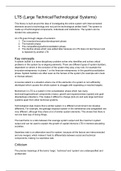Samenvatting
GEO2-2274 Science Technology and Society Summary
- Instelling
- Universiteit Utrecht (UU)
A summary of the course Science Technology and Society at Utrecht University (GEO-2274). Includes the theories Large Technical systems (LTS), Social Constructivism of Technology (SCOT), Actor-Network Theory (ANT), Multi-Level Perspective (MLP) and Strategic Niche Management (SNM) and the concepts o...
[Meer zien]




